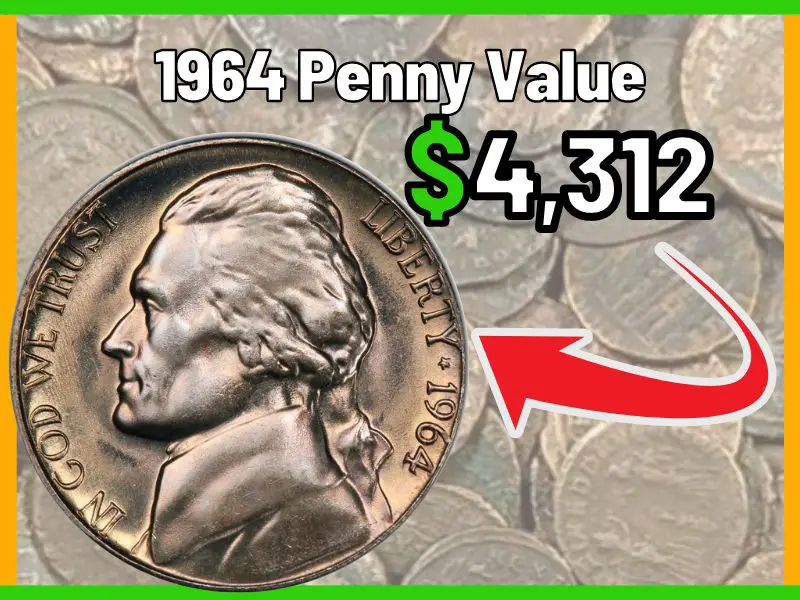
The 1964 penny value has a minimum of $0.15 regardless of whether it carries a mint mark or not. However, certain factors like coin condition and rarity can further increase its value. Extremely rare ones like the 1964 SMS penny can fetch thousands of dollars if you find one.
Most coin collectors bother less about how much a 1964 penny is worth but rather assemble a complete collection that includes even the rarest series. This article covers everything you need to know about the penny.
1964 Penny Identification Guide
1964 Penny Specifications |
|
| Type | Lincoln Penny |
| Year | 1964 |
| Face Value | $0.01 |
| Composition | 95% copper, 5% zinc |
| Total Weight | 3.11 grams (or over) |
| Diameter | 0.750 in. 19.05 mm |
| Thickness | 0.0598 inches (1.52 mm) |
| Edge | Plain |

Even though most people consider the 1964 penny almost worthless, it is very popular among numismatists. The coin belongs to the Lincoln penny series, a denomination with a long and eventful history.
First were the Lincoln wheat pennies with the wheat stalks on their reverse. The US Mint struck these series from 1909 until 1959, when the coins’ reverse took on a new design depicting the Lincoln Memorial. That began the Lincoln Memorial pennies, of which the 1964 penny is part.
This penny was minted in huge numbers and is, in fact, still in circulation today. It isn’t rare to find one of them in pocket change, making them easy to come by. While its features and designs remain the same as others in the Lincoln Memorial series, the 1964 penny has some unique variations.
1964 Penny Features
The 1964 penny carries the same features as other Lincoln Memorial coins on both the obverse and reverse. Only the coin’s production date is obviously different.
Obverse
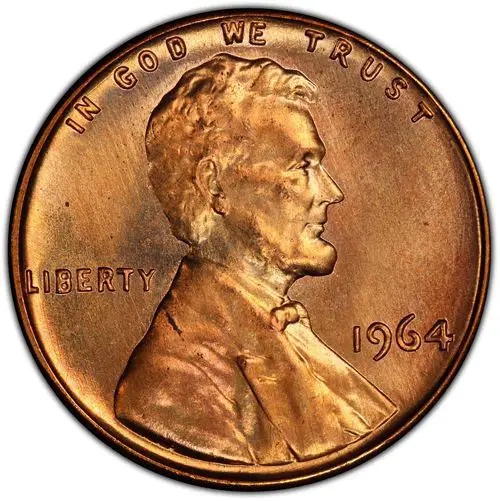
- Lincoln’s right side profile at the centre of the coin.
- “IN GOD WE TRUST” engraved along the coin’s top.
- “LIBERTY” engraved on the left side of the profile
- The coin’s production year, which in this case is 1964 engraved on the profile’s right side.
You will find the coin’s mint mark directly under its year of production. An absence of a mint mark mostly means that the Philadelphia mint struck the coin.
Reverse
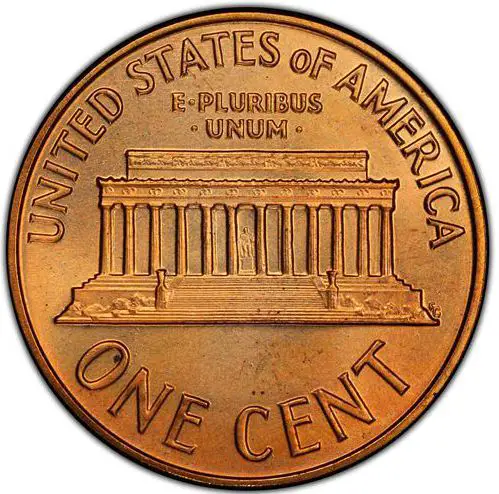
- A profile of the Lincoln Memorial at the coin’s center.
- “UNITED STATES OF AMERICA” struck along the top of the coin.
- “E PLURIBUS UNUM” engraved between the Memorial’s profile and the topmost inscription.
- The coin’s denomination which in this case is “ONE CENT” engraved at the coin’s bottom.
Finally, the 1964 penny does not have a teethed rim, it has a smooth one.
1964 Penny Series
1964 Penny Quantity Minted |
||
| Year | Location | Minted |
| 1964 D Penny | Denver | 3,799,071,500 |
| 1964 Penny No Mint Mark | Philadelphia | 2,648,575,000 |
| 1964 Proof Penny | Philadelphia | 3,950,762 |
| 1964 SMS Penny | – | – |
Unlike other coins, the 1964 Lincoln penny was struck at two mints which were ones at Denver and Philadelphia. As such, you can recognise each coin type by checking for a mint mark; if you find a “D”, it’s from the Denver Mint, while an absence of a letter means it is from the Philadelphia mint.
It is important to note that the US Mint had to make a difficult decision at some point during production. This decision made the mints produce coins without any mint mark, regardless of the facility minted them. The practice started because of a significant shortage in circulating 1964 pennies, we explain it better under the 1964 SMS penny.
1964 D Penny
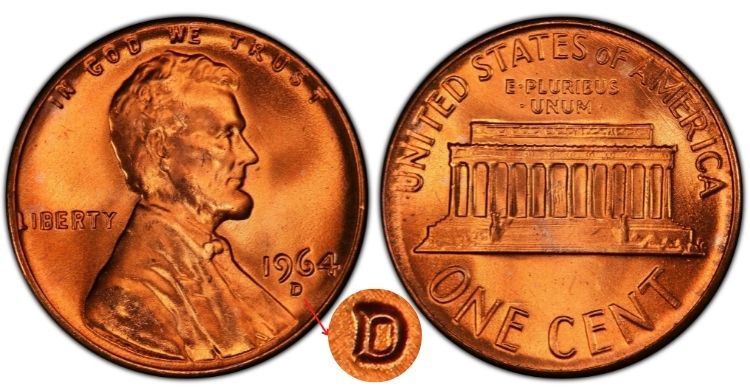
The Denver mint struck over 4 billion 1964 D penny in approximately a year. With such high mintage, these coins are very common, resulting in very low values even for those in excellent conditions or grades.
1964 Penny No Mint Mark

With a mintage of over 2 billion, coins from the Philadelphia mint carry no mint marks and are very common too. Like the ones from the Denver Mint, they also have abysmal value even in uncirculated states.
1964 Proof Penny
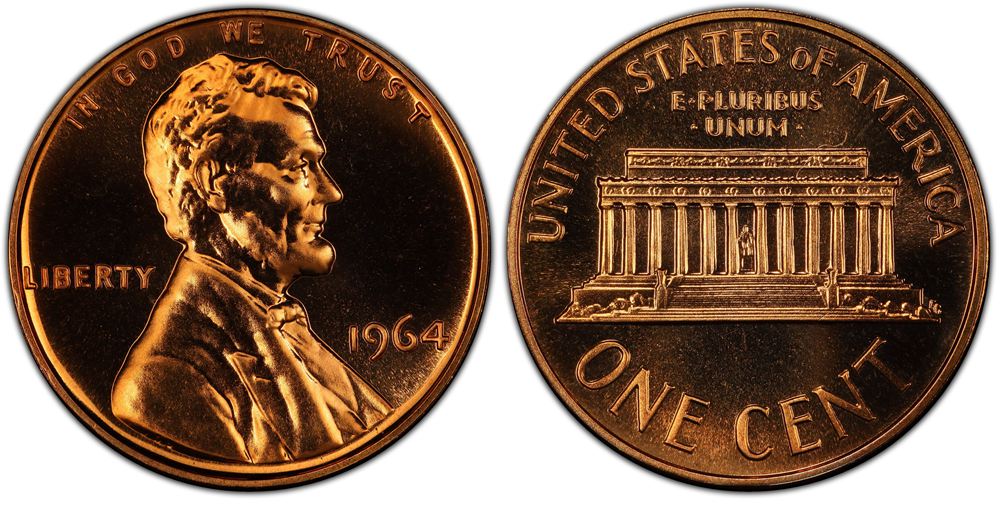
The Philadelphia Mint struck these proof pennies for coin collectors with a total mintage of 3.9 million. One can say these coins aren’t rare but also nowhere as common as the standard ones whose mintage number is in the billions.
As such, expect the 1964 proof penny value to be higher than the standard coins.
1964 SMS Penny

The SMS in this series stands for “Special Mint Set”, which already indicates the uniqueness of these coins. It is extremely rare to encounter one, and collectors highly value them. A 1964 SMS penny can easily fetch over $5000 at auctions, and one in excellent condition can sell for way higher than that.
Production of this coin started with a serious scarcity of silver coins due to hoarding. People were hoarding every silver coin, from dimes to quarters and half dollars. However, officials at the US Mint believed the scarcity was caused by coin collectors and decided on a solution. Production of proof and uncirculated coins meant to be collectibles would cease.
However, the mints would only strike Special Mint Sets, which would contain one coin of each denomination, and these coins would have a unique satin finish. Hence the production of the 1964 SMS Pennies.
Surprisingly though, these Special Mint Sets were never produced, making most collectors believe that the existing ones were struck as prototypes. The 1964 SMS Penny is very rare and has the highest value of the series.
Features of a 1964 SMS Penny
- An SMS penny has a smooth finish as opposed to the mirrorlike finish of a proof coin.
- The rim of a 1964 SMS penny has a rim with a more square profile than that of a 1964 Proof penny.
- Since the 1964 SMS Penny has the sole purpose of being a collectible, it has a clearer strike and more distinct details than the others meant for circulation.
- The rim displays the highest level of detail dispararity between an SMS penny and its counterparts.
1964 Penny Valuable Errors
Errors can either increase or decrease a coin’s value; in this case, we have compiled a 1964 penny error list. These anomalies generally increase the value and price that these coins can fetch at auctions.
1964 Penny No L in Liberty Error
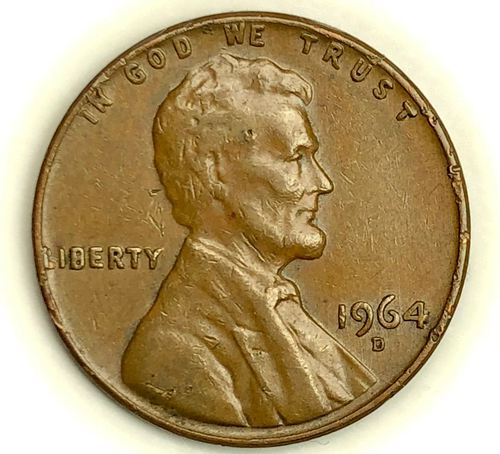
1964 Penny No L in Liberty Error Sold $19.95
Some 1964 pennies were struck in a way that engraved the word “LIBERTY” too close to the coin’s rim. This resulted in the “L” blending into the coin’s outer rim, creating a sort of absence of the letter in the word.
This error isn’t that rare but can significantly increase a 1964 penny value.
1964 D Penny Struck on 1963 D Penny
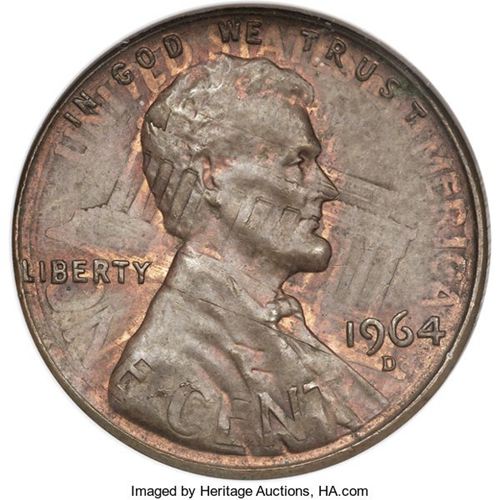
1964 D Penny Struck on 1963 D Penny Sold on Jan 10, 2009 for $4,312.50
This error occurred when the Denver Mint struck a 1964 D penny on a penny from the previous year (1963). You will see all the marking peculiar to a coin of this making. The markings include features of the previous coin showing underneath the 1964 D penny features.
A penny of this sort went for more than $4000 at the 2009 Heritage Auctions!
1964 Penny Triple Saddle Strike Error
A triple saddle strike error occurs when the coin is struck multiple times. For the 1964 penny error, you can see three Lincoln profiles on the coin’s obverse!
How Rare is the 1964 Penny?
The 1964 penny is in no way rare because of its high mintage. In fact, it is quite possible to find one in pocket change. However, when it comes to the 1964 SMS Pennies, the case is very different.
Numismatists estimate that only about 30 of these coins remain today, making them extremely rare and a very worthy find. It is important to note that counterfeit 1964 SMS pennies exist and make sure not to fall for one.
Factors That Influence a 1964 Penny Value
These attributes play a vital role in determining the penny’s value. Depending on these crucial factors, you can get more or less for your coin.
Grade
A coin’s grade basically refers to its condition at the time of sale. Even though it has a complex form, we have simplified it to four broad categories.
- Good: The coin shows signs of heavy damage and wear. Features have heavily blended into one another, successfully removing intricate details of the profiles and engravings.
- Fine: The coin still shows serious wear and scratches but is less intense than one in good condition. When examining it under a single light source, you can detect moderate discolouration on the coin.
- Extremely Fine: This category loosely covers the best states a coin can be in circulated condition. Scratches and wear look very mild, and the coin’s colouration remains even under examination. You can also observe all the coin’s features and details with the naked eye.
- Uncirculated: Although more intricate categories are under this grade, it generally means the coin has never been spent. It retains all its features from when it was minted. Coins with high grades in uncirculated conditions fetch the highest prices asides from proofs and error coins.
Various 1964 Penny Patina
A coin’s patina basically means its colouration, and it plays a huge role in its physical appeal and, ultimately, its value.
Brown Patina (BN)
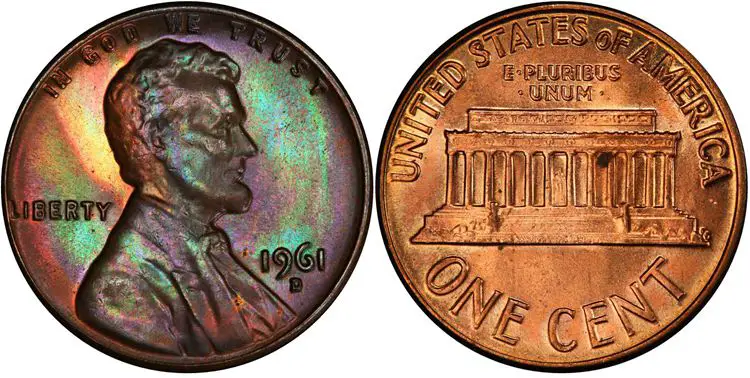
This patina is the most common of the three, showing that a coin is quite old. The brown colouration forms because of the coin’s exposure over time. Depending on the frequency of a coin’s exposure or exchange, you can also see bluish and greenish tints on the coin. They show that it hasn’t been exposed much.
Red and Brown (RB)
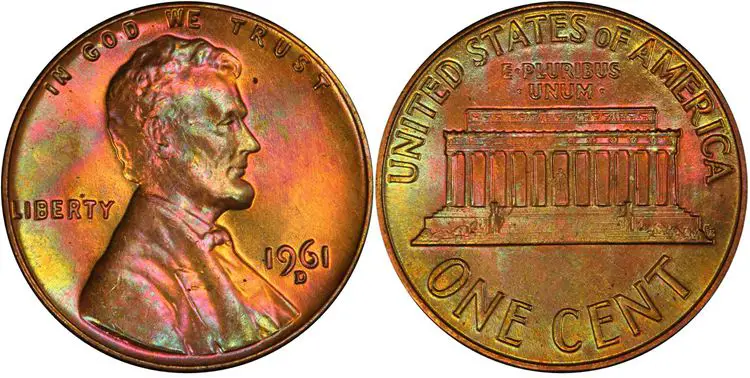
The red and brown patina is a mixture of the brown that comes with exposure and the red of freshly mint copper. You can tell that the coin has seen less circulation and exchange than one with a BN patina. RB is less common and therefore more valuable than the former.
Red (RD)

A red patina indicates the coin’s original colour after production. Coin collectors value it a lot because it shows excellent preservation. It is the rarest and most expensive of the 1964 penny patinas.
Rarity
A coin’s rarity can add or reduce its value. This is why coins with high mintage generally have low values. Simply put, the higher a coin’s availability, the lesser its value.
Demand
This factor covers the rate at which collectors snap up the coin. Naturally, the value of a coin rises in direct proportion to its demand. A better explanation is that higher demand for the coin reduces its availability while increasing its rarity simultaneously.
1964 Penny Value
Under this section, we will cover the prices of successful sales of 1964 Lincoln pennies and their Canadian counterparts.
Series |
MS 63 |
MS 64 |
MS 65 |
MS 66 |
MS 67 |
PR 69 |
1964 D Penny Value |
$6.50 |
$4.25 |
– |
|||
1964 Penny No Mint Mark |
– |
$5.99 |
– |
– |
$44 |
|
1964 Penny No Mint Mark (Off-center error) |
– |
– |
– |
– |
||
1964 D Penny (Double Struck) |
– |
– |
– |
– |
– |
Where to Buy or Sell Your 1964 Penny
Sometimes, the place you choose to make a sale or purchase can determine if you will get a good deal or not. Whether you are building a collection to sell or you are collecting coins as a hobby, these options are suitable.
Online Platforms/Marketplaces
Websites like eBay and Heritage Auctions are good for putting up your coin or collection for sale. They allow buyers to bid on the coin, with the highest bid winning the sale. However, it is always good to grade your coin before listing it to increase its value, especially if it has an excellent grade.
Local Coin and Pawn Shops
This option is perfect for those who see no need to wait long to make a sale. Most people prefer this for low-value coins since they can easily get paid in cash.
It is important to note that Currency Converters are also good ways to get a 1964 Lincoln penny since they are still in circulation.
Wrapping Up
The 1964 penny is part of a long-existing denomination that both honored a great President and also earned the public’s affection. Despite its current low value, it remains an important coin in the journey of every coin collector.
Furthermore, finding an extremely rare coin like the 1964 SMS penny can yield a huge amount of money. However, don’t forget that coins with the right errors can also bring in surprising values.
